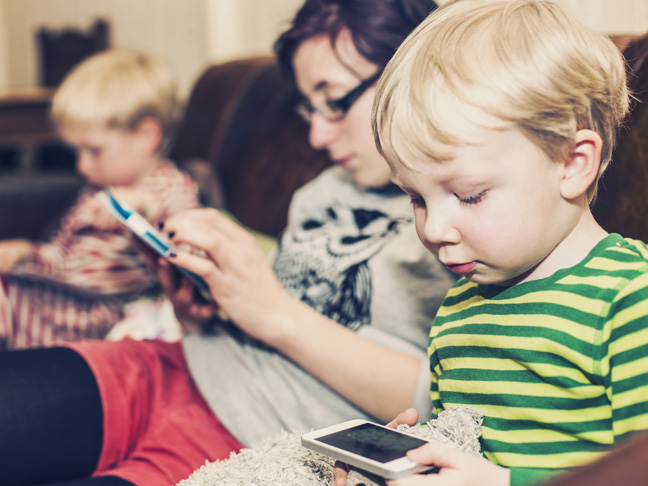I’m a child psychotherapist, and week after week for a solid year, a 6-year-old client sat on my couch and talked non-stop about his favorite video game. Wringing his hands and pacing the room when the need to play took hold, he described the game in great detail. He talked about the moves he stayed up late thinking about. He talked about the failures of his last attempt to play and how he planned to correct those mistakes. He twirled his hair, anxiety lingered beneath every word, and he hated when his video game talk time came to an end. I had to set limits on the amount of time he discussed the mechanics of the game, because otherwise he got stuck in an anxious loop. The same one that led to sleepless nights, poor school performance, and lack of friendships.
He wasn’t the only one. I’ve worked with high school students who threw everything away — friends, grades, college acceptances — all in the name of digital addiction. Some preferred video games; others were glued to Twitter and Instagram. Social media can make or break your day when it’s the only thing that matters to you, after all.
“Everything in moderation” is the catchphrase of the day when it comes to use of technology, video games, and overall screen time. A little here and a little there is just fine, seems to be the general consensus among parents. But how closely are parents actually monitoring that screen time? Are parents taking Internet use, social media, TV, video games, so-called educational apps, and texting into account when those minutes are calculated?
I’m the mean mom who takes a hard line on digital consumption. Yes, my kids know how to use a laptop, can work my iPad with ease, and they use old iPhones for music and cameras. We don’t hide our heads in the sand around here when it comes to technology, and I want them to learn to use the tools available to them. But I’ve also seen the negative effects of technology.
I once downloaded a read and race game for my son. He reads a book, then gets to race a car once the book is over. It’s a fun app and the reading takes up more time than the racing, so what could be the issue? I watched one day as he became so fixated on the race that he started shaking. He was frustrated with the lack of control over the race and I could see his muscles tense, his jaw clench, and his demeanor change. That was the end of that game.
It’s difficult to quantify digital addiction (which is not classified as a disorder in the current edition of the Diagnostic and Statistical Manual of Mental Disorders), but a 2009 study found that 8 percent of kids between the ages of 8 and 18 qualify as addicted. That’s three million kids worldwide, who are experiencing mood swings, sleep deprivation, and symptoms of depression due to digital consumption.
My son recently asked to try the racing game again. He loves cars and burns through books about NASCAR, Indy Racing, and Stock Cars. Every fiber of my being wanted to say no without giving it a second thought. Seeing him fall apart because of a game was just too much. It’s unnecessary stress, and I believe in eliminating unnecessary stress. But he is surrounded by fellow kindergarten students who play a lot of video games. He hears about games at recess and during lunch. He’s curious, and that’s perfectly natural.
So we have honest conversations about video games. He knows, for example, that games are designed to introduce new and exciting features at set intervals to get kids hooked. He knows that no matter how many coins you purchase for a game, the game will always cue to buy more. He knows that’s a dead end street, and one we won’t travel in this house. He knows that too much screen time causes headaches, sleep problems, and feelings of anxiety.
And he gets to play his game for ten minutes on Saturday mornings with his dad. Ten minutes. No exceptions. And the truth is, that’s all he needs. Stepping back and educating my kids about the reality of too much technology empowered them to make healthy choices and take control of their own well-being. Some nights they cuddle up together and work on building a reef for Nemo with my iPad for about five minutes, but most of the time they choose to play with their toys, instead. Where once I thought I might have to hide away my technology to remove the temptation, I found that educating them and empowering them taught them to make better choices.
Digital addiction might not have an official classification, but I can assure you that it is a real danger for our kids. It can have long-term effects on relationships, education, and physical health. As Cosette Rae shared in this article, digital addiction can significantly interfere with the life you want to live.
A few signs that your child spends too much time glued to technology:
1. Mood swings, ranging from anger to frustration, when tech time is interrupted or technology is unavailable
2. Internet use interferes with normal daily activities, such as getting ready for school, eating, sleeping, and playing
3. Symptoms of anxiety, including stomachaches and headaches, as well as nervous behaviors like twirling hair and biting nails
4. An obsession with technology, talking about it constantly and/or getting distracted by thoughts about it
5. Trouble focusing in school and/or while doing homework
6. Lack of interest in other activities, which can negatively impact friendships
7. Telling lies to get extra screen time
8. Trouble sleeping, both falling asleep and staying asleep
We have the opportunity to help our children avoid digital addiction. Educate them. Empower them to make healthy choices. And set the limits that will promote better emotional health within the family.
Photo: Getty








